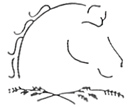Sabino Gene - The Newest Morgan Color PINTO
by Sue White, PineHaven Morgan Farm (published with her permission)
When most people think of pintos, they picture a spotted horse with loud black and white markings. The Morgan world hasn't seen the Pinto coloring in their breed for many years due to the high white rule. These horses are not the loud pintos that we normally think of, but they have the genetic ability to produce louder spotted offspring. This is where the story begins on the newest Morgan color, Pinto.
There are several different genes that produce the pintos coloring, tobiano and overo are the two that most often come to mind but there are several other spotting patterns that are less understood and even more confusing. All of the pinto genes are thought to be dominate, which means that one parent has to be a pinto, & the gene does not skip a generation. even the most minimally marked tobianos are almost always easily recognizable as a tobiano but the minimally marked overo may look like a solid horse with a couple of socks or stockings. It is felt that there are at least three different genes that cause what most spotted registries refer to as 'overo' pinto coloring. These are, frame, splash white, and the sabino genes. Most of the PInto and Paint registries lump these 3 different overo patterns under the single category of overo.
In our registered Morgans, it is felt that the only spotting gene to have survived is the sabino gene (though there is one older, loud palomino overo mare, that has since been registered, since the repeal of the high white rule). Sabino (sah-BEE-no) is a Spanish word that means 'a roaned pattern.' At present, our Morgans are considered minimally marked sabinos, these horses may only display a stocking or two and a blaze but otherwise they will appear to be a solid colored horse. There are in fact several registered Morgans that have enough white on their body to be double registered as Pintos. These louder sabino Morgans will normally have a good deal of white on their face, some have very loud facial markings like apron or bald faces. High over the knee or hock stockings, disconnected spots on the legs and belly spots are also characteristic of the sabino gene. Most of our sabino Morgans are chestnuts and many have roaning in their coats. This gene shows up stronger on the chestnut colored horse (in our Morgans) and is less noticeable on bay and black horses. The white leg markings on a sabino differs from non-sabinos, in that the markings tend to have narow pointed extensions that run up the legs, also very irregular, lacy and jagged edges.
Now that we know what our sabino Morgans look like today, lets move on to the future. How can we produce louder Pinto color patterns in our Morgans? We have to start from scratch. By breeding two minimally marked sabino Morgans together we should start seeing louder marked horses. There are a number of Paint horse breeders who have been breeding 'croupouts' together to produce the highest instances of pinto color. A 'croupout' is a horse with high white that is produced from two solid colored parents. One or possible both, of the parents carry the overo gene but appear to be solid in color. In most cases these Paint cropouts are in fact minimally marked sabinos. The variations in these Paint sabinos is amazing from solid colored horses, to horses with extensiver roaning, bald faces, belly white and stockings that run up the stifles, to the extreme expression of the gene, a solid white horse. Unlike the frame overo gene, you can breed two sabinos together and produce a solid white healthy foal; not the lethal white foals that are produced by the frame overo crosses. If and when we produce a sabino white Morgan or a loud sabino Morgan, these horses will produce a high percentage of spotted offspring.
Clydesdale breeders have learned to manipulate the sabino markings in their horses for years. They prefer white on the lower portion of their horses in the form of white legs and some belly white. These breeders will usually breed horses with four white feet to a horse with at least one dark foot. In most cases, they will produce some patches of roan on the body and white on the legs but not too much more. With the endless pattern variations this gene can produce, it may take time to learn what breeding combinations work best in our Morgans.
Sabino bred to a non-sabino will produce the gene 50% of the time, but sabino breed to another sabino will produce the gene 75% of the time. This is how you should start seeing more strongly marked pintos. By breeding two sabinos together you could get anything from solid colored, to spotted, to a solid white horse.
So what do we look for in our minimally marked sabino Morgans when trying to breed for louder color?
*A history of high white or a consistent amount of white being produced within a line of Morgans.
*A large blaze, apron blaze or bald face and/or white that continues onto the lower lip.
*Rear stockings that run higher up the front of the leg and lower in the back.
*Markings with lacy, roaned, or irregular edges (not a clean edge).
*Disconnected white spots below the knee or hock (or not connected to a sock or stocking).
*White hairs mixed through out the coat (roaning is often associated with this gene)
*Chestnut colored Morgans seem to carry or display the gene stronger than darker horses.
It may take the Morgan world some time to see and accept loud spotted Morgans but when the time comes, it may bring us new buyers and members.. .this new color will definately be a hot commodity.

